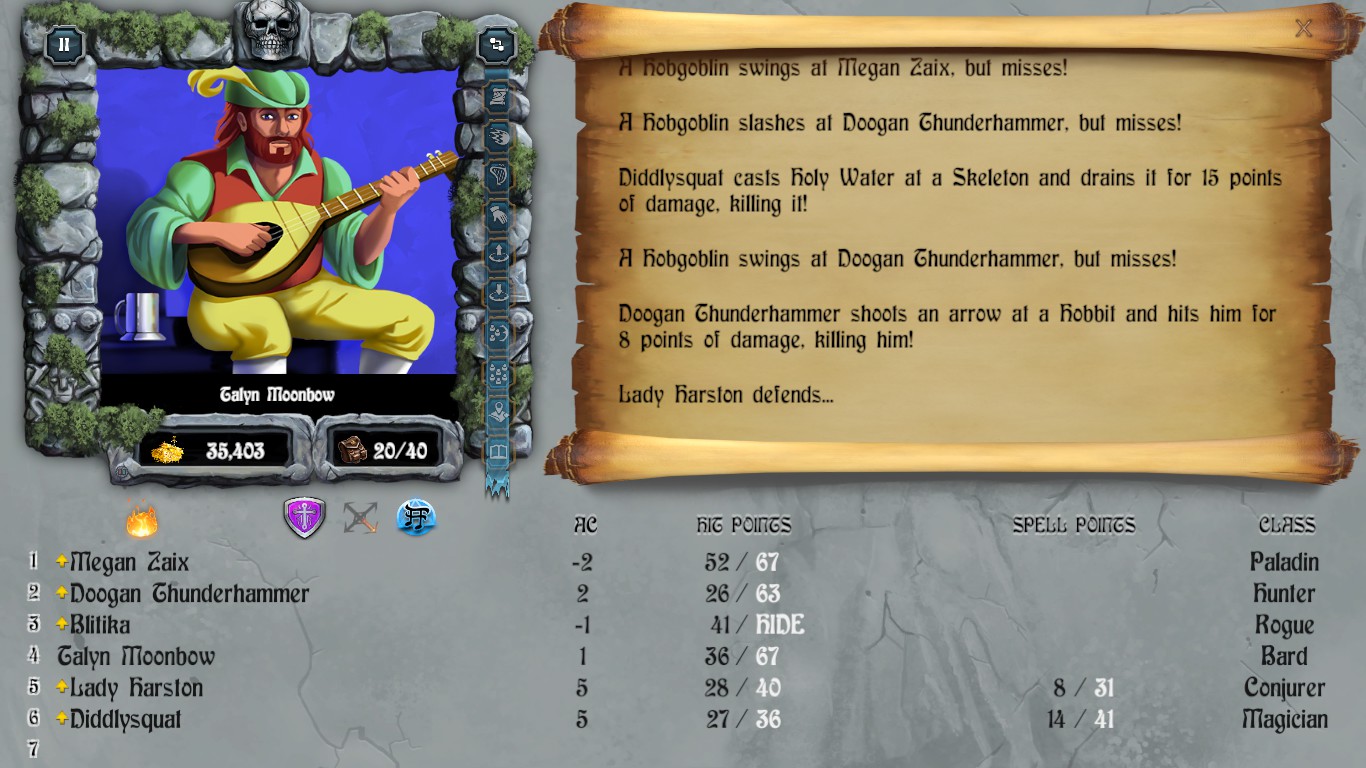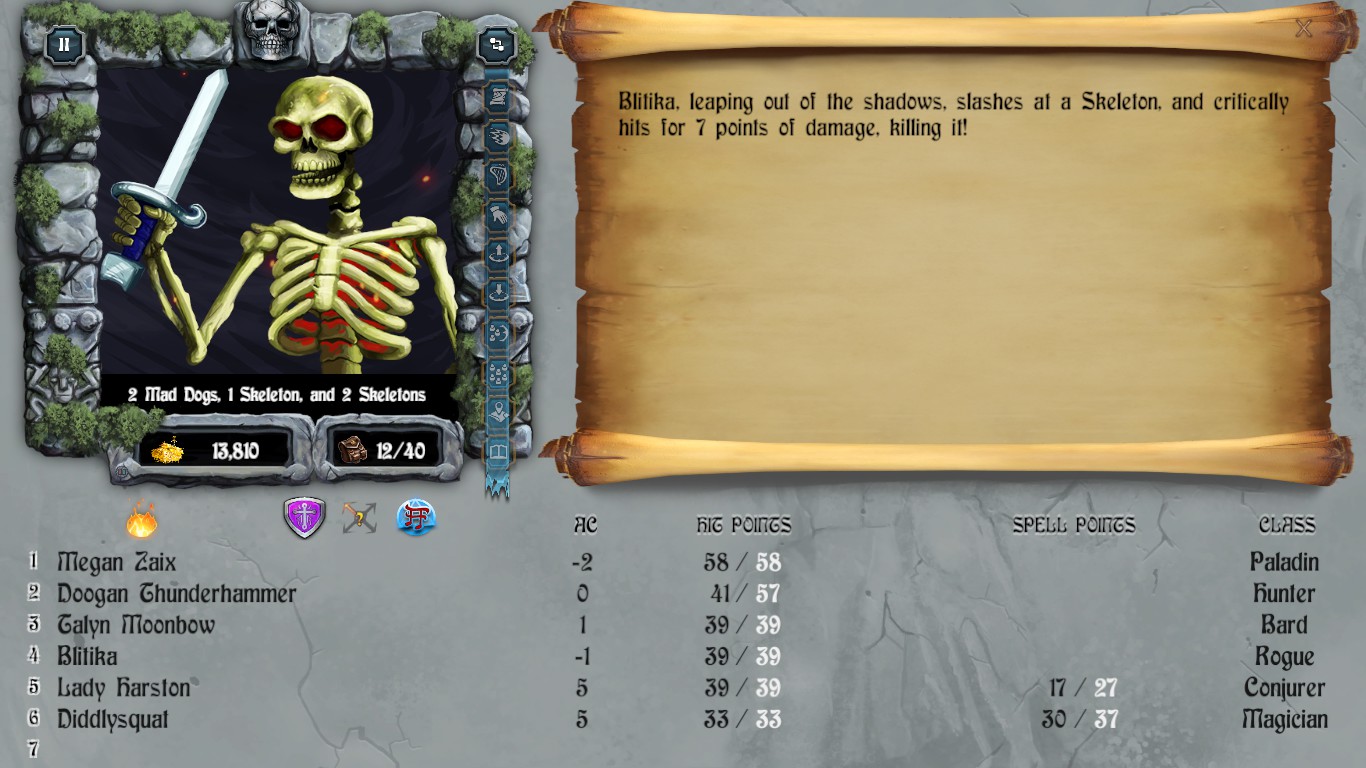Search
[{{{type}}}] {{{reason}}}
{{/data.error.root_cause}}{{{_source.title}}} {{#_source.showPrice}} {{{_source.displayPrice}}} {{/_source.showPrice}}
{{#_source.showLink}} {{/_source.showLink}} {{#_source.showDate}}{{{_source.displayDate}}}
{{/_source.showDate}}{{{_source.description}}}
{{#_source.additionalInfo}}{{#_source.additionalFields}} {{#title}} {{{label}}}: {{{title}}} {{/title}} {{/_source.additionalFields}}
{{/_source.additionalInfo}}- Details
- Category: Computer
- By J. Todd Cumming
- Hits: 2650
The Bard's Tale Trilogy (PC)

The Bard's Tale Trilogy
Developed by: Krome Studios
Published by: inXile Entertainment
Released: August 14, 2018
Available on: Windows
Genre: Role-playing
Number of players: 1
Price: $14.99
The Bard's Tale: Tales of the Unknown was originally released in 1985 for nearly every type of computer system of that age, including the Amiga, the Apple IIe, MS-DOS and even the original NES. The game spawned two sequels and several novels based on the world it was set in. It was considered revolutionary at its time, being one of the first computer role-playing games to sport “3D graphics” and animated character sprites. It still appears on many lists as one of the greatest computer role-playing games of all time.
In 2018, inXile Entertainment announced that they were creating a sequel to the original trilogy, called Bard's Tale IV: Barrow's Deep. (Oddly enough, inXile also developed another game called the Bard's Tale, released in 2004, but bore very little resemblance to the original trilogy. A review of that game can be found on this Web site, here.) As part of the Kickstarter to fund Bard's Tale IV, inXile offered to revamp the original Bard's Tale trilogy and release it for backers. The trilogy was soon made available to the general public through Steam and GoG.com, with the third chapter added to the collection in February, 2019.
The Bard's Tale Trilogy consists of the first three games: Tales of the Unknown, the Destiny Knight, and Thief of Fate. In the first game, the town of Skara Brae is afflicted by a cursed, eternal winter, and all the guardsmen have vanished. Instead, dangerous monsters and bandits roam the streets. It's up to a party of adventurers to find the evil wizard, Mangar, and defeat him in order to break the curse. Players can carry the characters from the first game into the second chapter, where the players much search the wilderness and various locations in order to find pieces of the Destiny Wand to defeat the evil archmage, Lagoth Zanta. Finally, in the third chapter, the characters learn that Skara Brae has been destroyed by the Mad God Tarjan. It is up to them to travel to different worlds to assemble the components of a weapon powerful enough to destroy the Mad God for good.
In all three games, the game play is the same. The party navigates their surroundings by viewing it through a window in the upper left corner of the screen. This window will change when the party engages in combat or talks to a merchant or other characters. Combat is turn-based. The player chooses what action each of the characters will take that turn. The actions then play out through the text window, located in the upper right corner. Combat will continue in this back-and-forth fashion until all the opponents are defeated, or the party is killed. The bottom part of the screen contains all the vital statistics of the player's characters, including a display of what “buffs” are currently active. As with most role-playing games, the party receives experience points after each combat. Once enough points are accumulated, the party can gain levels, becoming more powerful.

Strong Points: Faithful recreation of the original game; long adventure; decent music
Weak Points: Somewhat repetitious; some grinding necessary; can be frustrating when starting out
Moral Warnings: Undead and demons present in game; magic use strongly encouraged; players can summon demons to assist them; use of alcohol
One of the interesting elements of the game are the magic users. At the start, players can only choose one of two classes of spell caster – either the conjurer or the magician. Once those characters get high enough level, they can switch to another spell casting class, which would now include wizard or sorcerer. In the two sequels, these choices can also include archmage, chronomancer or geomancer. Each class has its own selection of spells to choose from, and spells that the character had learned previously can still be used. Sadly, none of the other classes have the options to change into other classes in the same fashion, which makes their ability to level up somewhat routine.
The bard is another interesting class in that it is capable of playing songs that act as long-lasting buffs. As long as the bard can sing, the spell is in effect. These songs include ones that can provide light, one that can heal the party, one that protects the party from magical effects, and more. These songs also provide some of the only background music in the game, with each song being distinct. As a nice touch, each song also has a different sound based upon whatever instrument the bard has equipped at the time. However, in order to change songs or begin singing, the bard must “wet his whistle,” as it were, and that takes alcohol. While there do not seem to be any penalties for drinking – or even the ability to get completely intoxicated – the fact that some of the characters need to drink in order to use their abilities may cause some players to pause.
The game can be difficult when first starting out. Low level characters should stick to exploring the city until they get strong enough to survive their first excursion to the cellars, and even then they shouldn't wander too far from the local temple, where healing can take place. Spell regeneration also takes place only in the sunlight or by purchasing a “recharge” from one place in the city, which can be an expensive prospect. Once the party gets to level five or six they have a better time of surviving, but at the lowest levels it can be a bit frustrating.
The revamped trilogy remains faithful to the original source material, even if little of the original code remains. I remember playing the first game myself, and having to use a book of graph paper to map out all of the dungeons. In fact, the Bard's Tale even served as inspiration for me to design my own game worlds for tabletop games at that time. With this new trilogy, though, many of the limitations of the past have been lifted. There is now the ability to use the mouse or game controller, an automapping feature, and the ability to save anywhere in the game, rather than at certain checkpoints. Multiple save slots also are an option. The game also sports a bestiary and reproductions of the original maps and manuals. A new feature that was introduced in the latest patch – August 13, 2019 – allows the user interface to be changed so that the 3D display can take up the entire left half of the screen, rather than one corner.

Higher is better
(10/10 is perfect)
Game Score - 82%
Gameplay - 16/20
Graphics - 8/10
Sound - 8/10
Stability - 4/5
Controls - 5/5
Morality Score - 74%
Violence - 6/10
Language - 8/10
Sexual Content - 10/10
Occult/Supernatural - 3/10
Cultural/Moral/Ethical - 10/10
Despite the dedication and loyalty to the source material, there are still a few facets of the game that haven't aged well. Even though the original graphics have been touched up – including actual 3D and lighting effects for the town and dungeon – some of the sprites still look a bit on the wonky side. There are a variety of character portraits that can be chosen – many more options than the original games - but many of them still leave something to be desired (none of them really look like a female dwarven hunter!) Also, the game sometimes takes an agonizingly long time to load (around 10 minutes the first time I tried to play it), and I have experienced the occasional crash-to-desktop.
On the moral front, probably the biggest concern would be the aforementioned spell casters. In order to do well in the game, having at least one spell caster is pretty much required, and two would be better. Some of the spells that can be cast will summon undead monsters to serve you – and when playing a wizard character, these even include demons. Speaking of which, demons are an enemy that you will frequently face, as well as undead monsters like zombies and vampires. Some of the pictures can be gruesome (such as the zombie, which is covered in blood and appears to be gnawing on raw, dripping meat). There are several temples in the game where the players can get healed by donating money, but with the exception of the Mad God Tarjan and a couple of the Norse deities, there are no references to specific gods. The minor swears of h*ll and d**n also appear, but not frequently.
All in all, this faithful recreation of the Bard's Tale games is definitely worth checking out! The new version also includes achievements and Steam trading cards, for those who purchase it on Steam. For role-playing game enthusiasts that remember the classics, or want to experience them for the first time, this is one to add to the game library.








